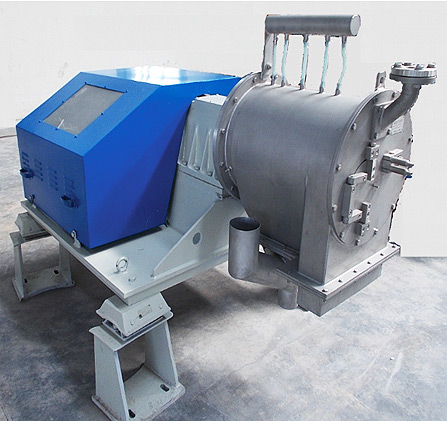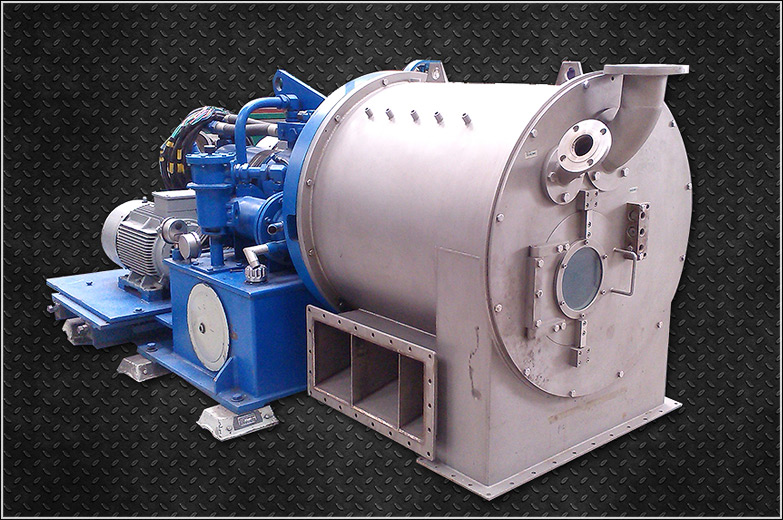Pusher Centrifuges
 Pusher centrifuge is a continuous filtering device used for solid-liquid separation which finds extensive use in chemical, pharmaceutical, food (common salt) and mineral industries. Pushers have been in use for more than half a century for dewatering relatively large, free-draining crystals and other solids.
Pusher centrifuge is a continuous filtering device used for solid-liquid separation which finds extensive use in chemical, pharmaceutical, food (common salt) and mineral industries. Pushers have been in use for more than half a century for dewatering relatively large, free-draining crystals and other solids.
Various types of centrifuges are available in the market, and each type has certain advantages over a specific range of process variables. Pusher Centrifuge has been known to be highly effective for feeds of wide ranging solid-content with particle size varying from 80 microns to a few mm.
It has an axially mounted cylindrical basket and a filtering screen made of trapezoidal bars. The slurry is fed into the narrower end of the basket and a reciprocating piston pushes the cake formed on the screen forward but the stroke of the piston stops just short of the broader end of the basket. This enables a thick layer of cake to remain at the discharge end which serves as a rim to prevent short-circuiting of the feed slurry. This way, the discharged wet cake comes out with minimal liquid content.
Pusher Centrifuge has a special design that minimizes moisture (or solvent) and breakage of crystals in the product. Sedimentation and filtration occur simultaneously in the Pusher.

Centrifugal Separation Technology with Guaranteed Endurance:
Fenix pusher centrifuge ensures maximum online availability with minimum maintenance and low floor-space requirement in most solid/liquid separation processes.
Used in diverse industry sectors such as bulk chemicals, pharmaceuticals, mining & minerals, common salt (sodium chloride), plastics processing, fiber industry etc., pusher centrifuges offer a host of advantages.
- Increased performance with high product quality through proper selection of the basket configuration, feed accelerator and screens.
- Choice of drives : Mechanical and hydraulic drives are available for greater flexibility of operation
- Simple maintenance through service-friendly design
- Quick installation on resilient vibration dampers
Pusher Operation
Briefly, here's how a Fenix Pusher Centrifuge operates:
Solids collect on the screen and feed liquors drain through.
The pusher plate rotates with the basket and reciprocates.
On the forward stroke, the plate pushes solids along the screen, consolidating the solids into a uniform cake. On the reverse stroke, fresh screen is exposed and more slurry is deposited.
Cake dries as it moves along the length of the screen and wash liquor may be applied to remove impurities.
Cake is pushed off the discharge end of the screen and directed to the collection chute for downstream processing.
Main Applications
ABS, adipic acid, ammonium chloride, ammonium sulfate, borax, calcium nitrate, common salt, cellulose acetate, dichlorobenzene, ferrous sulphate, hexamine, hydroquinone, lithium compounds, nickel sulphate, nitrocellulose, oxalic acid, possium carbonate, potassium chloride, sodium chloride, sodium bicarbonate, sodium carbonate, sodium chlorate, sodium cyanide, urea and in general ANY crystalline inorganic salt.
Key Characteristics:
- Process : Continuous
- Solids content : >20% by wt
- Average particle size : 80 - 2000 µm
- Solids throughput : Up to 25,000 kg/hr
- Solids recovery : >98%
- MOC : Stainless Steel, special materials
Advantages:
- Simple & Continuous operation
- High wash efficiency
- Eliminates manual handling
- Low energy consumption
- No spillage
- Low floor space requirement
- High yields
- Maintenance: simple & low-cost
- High throughput
Limitations:
- Minimum particle size: 50 µm
- Maximum particle size: About 1500 µm
- Feed requirement: High concentration of solid
Main Components & Spares:
- Shaft Baskets
- Feed Funnel
- Rotating Screens or Sieves
- Pusher plate
All major components and spares are available from Fenix on order.
